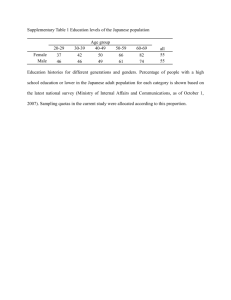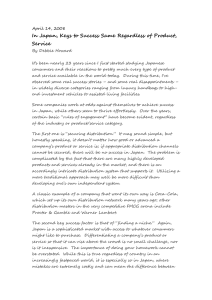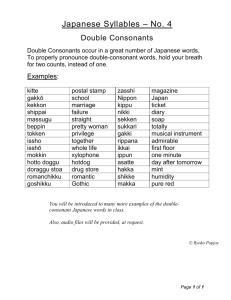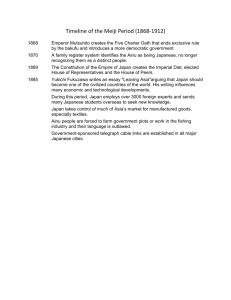Work-Life in Japan
advertisement
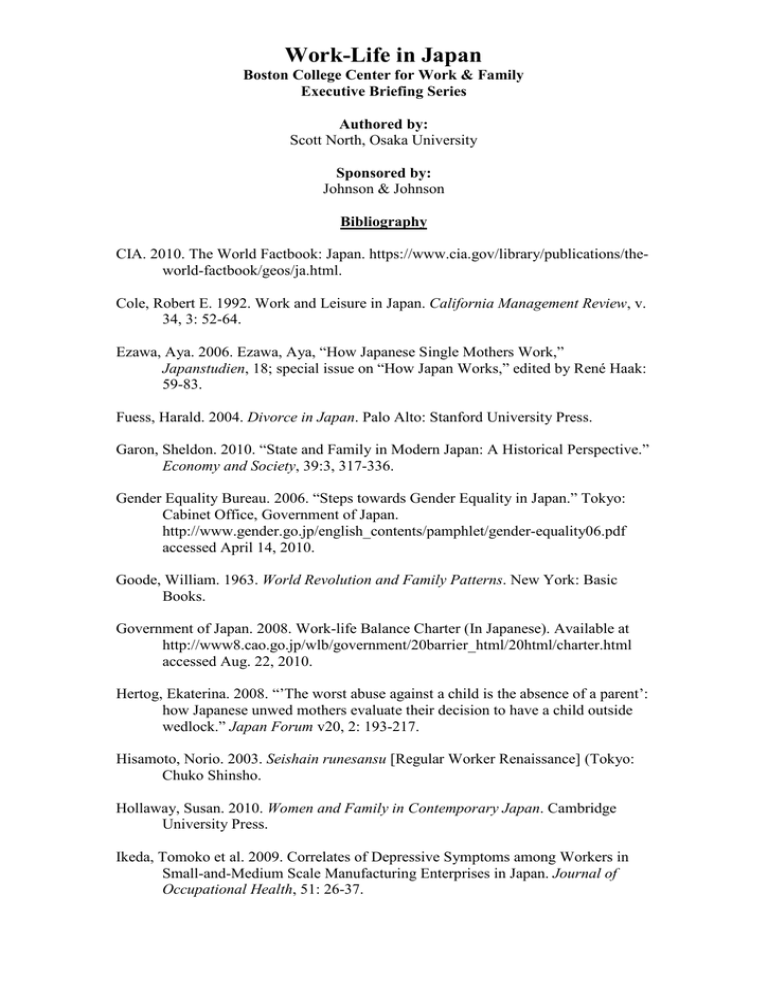
Work-Life in Japan Boston College Center for Work & Family Executive Briefing Series Authored by: Scott North, Osaka University Sponsored by: Johnson & Johnson Bibliography CIA. 2010. The World Factbook: Japan. https://www.cia.gov/library/publications/theworld-factbook/geos/ja.html. Cole, Robert E. 1992. Work and Leisure in Japan. California Management Review, v. 34, 3: 52-64. Ezawa, Aya. 2006. Ezawa, Aya, “How Japanese Single Mothers Work,” Japanstudien, 18; special issue on “How Japan Works,” edited by René Haak: 59-83. Fuess, Harald. 2004. Divorce in Japan. Palo Alto: Stanford University Press. Garon, Sheldon. 2010. “State and Family in Modern Japan: A Historical Perspective.” Economy and Society, 39:3, 317-336. Gender Equality Bureau. 2006. “Steps towards Gender Equality in Japan.” Tokyo: Cabinet Office, Government of Japan. http://www.gender.go.jp/english_contents/pamphlet/gender-equality06.pdf accessed April 14, 2010. Goode, William. 1963. World Revolution and Family Patterns. New York: Basic Books. Government of Japan. 2008. Work-life Balance Charter (In Japanese). Available at http://www8.cao.go.jp/wlb/government/20barrier_html/20html/charter.html accessed Aug. 22, 2010. Hertog, Ekaterina. 2008. “’The worst abuse against a child is the absence of a parent’: how Japanese unwed mothers evaluate their decision to have a child outside wedlock.” Japan Forum v20, 2: 193-217. Hisamoto, Norio. 2003. Seishain runesansu [Regular Worker Renaissance] (Tokyo: Chuko Shinsho. Hollaway, Susan. 2010. Women and Family in Contemporary Japan. Cambridge University Press. Ikeda, Tomoko et al. 2009. Correlates of Depressive Symptoms among Workers in Small-and-Medium Scale Manufacturing Enterprises in Japan. Journal of Occupational Health, 51: 26-37. Ito, Kimio. 1996. Dansei gaku nyûmon. (Introduction to Men's Studies). Tokyo: Sakuhin Sha. Japan Institute for Labour Policy and Training. 2010. Japanese Working Life Profile: 2009/2010 Labor Statistics. Tokyo: Japan Institute for Labour Policy and Training. Japan Times. 2010. “Female execs still scarce after labor law debut.” August 30. http://search.japantimes.co.jp/cgi-bin/nn20100830a1.html. Accessed Aug. 30, 2010. Johnson, Chalmers. 1982. MITI and the Japanese Miracle: The Growth of Industrial Policy, 1925-1975. Palo Alto, CA: Stanford University Press. Kyodo News. 2010. “Child care leave dips for first time.” The Japan Times, July 18. http://search.japantimes.co.jp/cgi-bin/nn20100718a8.html accessed October 2, 2010. Kageyama, Yuri. 1999. ‘Japan says dads should help out more’ San Francisco Chronicle, 24 April: A14. Leheny, David. 2003. The Rules of Play: National Identity and the Shaping of Japanese Leisure. Ithaca: Cornell University Press. Lewis, Jane. 2001. “The Decline of the Male Breadwinner Model: Implications for Work and Care.” Social Politics (Summer): 152-169. Linhart, Sepp. 1998. “Introduction: The Japanese at Play: A Little Known Dimension of Japan.” In The Culture of Japan as Seen through Its Leisure. Sepp Linhart and Sabine Frühstück eds. Albany: State University of New York Press. 1-21. Mainichi Broadcasting. 2010. MBS Voice. Online transcript of June 29 broadcast entitled, “Shigoto to katei no besuto baransu ha?” (What is the best balance between work and household life?). MHLW (Ministry of Health, Labour, and Welfare). 2008. Heisei 19 Nenban Hataraku Josei no Jitsujô (Situation of Working Women, 2007). Available at http://www.mhlw.go.jp/houdou/2008/03/h0328-1.html. (accessed 4 February 2009). MHLW. 2009a. Shigo to seikatsu no chôwa (wa-ku rairu baransu) to kôkyaku ne-zu ni kan suru ishiki chôusa no kouhyô ni tsuite [Results of a survey of attitudes regarding consumer needs and work-life harmonization (work-life balance). Ministry of Health, Labour and Welfare. Government of Japan. http://www8.cao.go.jp/wlb/research/pdf/needs.pdf accessed Sept. 2, 2010. MHLW. 2009b. A Declining Birthrate White Paper (Summary) http://www8.cao.go.jp/shoushi/whitepaper/english/w-2009/index.html accessed September 2, 2010. 2 MHLW. 2009c. Results Summary of the Heisei 20 (2008) Employment Equality Survey (in Japanese) Tokyo: Government of Japan. http://www.mhlw.go.jp/houdou/2009/08/dl/h0881-02a.pdf (accessed 05/12/2010). MHLW. 2009d. Introduction to the revised Child Care and Family Care Leave Law http://www/mhlw.go.jp/English/policy/affairs/dl/05.pdf accessed Sept. 14, 2010. Morioka, Koji. 2007. ‘The New Overwork and the White-Collar Exemption’ (in Japanese) in Morioka K. (ed.) Kakusa shakai no kouzô: gurôbaru shihon shugi no dansou Tokyo: Sakurai Shoten, 51-83. Morioka, Kōji. 2008. ‘Rōdō konpuraiansu no jittai to saabisu zangyō’ [Labor Compliance and Unpaid Overtime]. Report presented for Hatarakikata Net Osaka, Osaka (10 April). Mouer, Ross and Kawanishi Hirosuke. 2005. A Sociology of Work in Japan. London: Cambridge University Press. Muta, Kazue. 2008. Sexual Harassment and Corporate Culture in Japan. In Stevi Jackson, Liu Jieyu, and Woo Juhyun eds., East Asian Sexualities: Modernity, Gender, and New Sexual Cultures. New York: Zed Books; 52-68. North, Scott. 2010a. “Changes in Japanese Fatherhood after Two Decades of Recession.” Paper presented at the Center for Research on Families and Relationships, University of Edinburgh, Scotland, July 18. North, Scott. 2010b. “Hello Work, Sayonara Koyô? Less Secure Employment and the Zeitgiest of Japan’s Lost Decade.” In Globalization, Localization, and Japanese Studies in the Asia-Pacific Region, Vol. 2: 67-85. Ed. James C. Baxter. International Research Center for Japanese Studies. Ochiai, Emiko. 1997. The Japanese Family System in Transition. Kyoto: International Research Center for Japanese Studies. OECD. 2010. “OECD Health Data: How Does Japan Compare?” http://www.oecd.org/dataoecd/45/51/38979974.pdf accessed Sept. 17, 2010. Ogasawara, Yuko. 1998. Office Ladies and Salaried Men: Gender, Power and Work in Japanese Companies. Berkeley: University of California Press. Ota, M. (1999) ‘Dad takes child-care leave.’ Hoffman, M. (trans.) Japan Quarterly 46, 1: 83-99. Ozawa, Mari. 2002. Twelve Million Full-Time Housewives: The Gender Consequences of Japan’s Postwar Social Contract. In Social Contracts Under Stress: The Middle Classes of America, Europe, and Japan at the Turn of the 3 Century, edited by Oliver Zunz, Leonard Schoppa, and Nobuhiro Hiwatari. New York: Russell Sage Foundation; 255-277. Roberson, James and Nobue Suzuki eds. 2003. Men and Masculinities in Japan: Dislocating the Salaryman Doxa. London: RoutledgeCurzon. Rohlen, Thomas C. 1974. For Harmony and Strength: Japanese White-Collar Organization in Anthropological Perspective. Berkeley: University of California Press. Sato, Hiroki, Osawa Mari, and Charles Weathers. 2001. “’Atypical’ and ‘Irregular’ Labour in Contemporary Japan: The Authors Debate.” Social Science Japan Journal 4: 219–223. Smith, Thomas C. 1986. “Peasant Time and Factory Time in Japan.” Past and Present, 111, 1: 165-197. Taga, Futoshi. 2006. Otokorashisa no shakaigaku: yuragu otoko no raifu kôsu [The sociology of manliness: fluctuations in men’s life course]. Tokyo: Seikai Shisho Sha. Toivonen, Tuukka. 2010 (forthcoming). “Is There Life after Work for Japan? Political ‘Work–Life Balance’ Research Begins to Address the Hard Questions.” Social Science Japan Journal first published online September 8, 2010 doi:10.1093/ssjj/jyq041 Tokuhisa, Tamao. 1980. “Tourism within, from and to Japan.” International Social Science Journal, 32, 1: 128-150. Vogel, Ezra. 1971. Japan’s New Middle Class: The Salaryman and His Family in a Tokyo Suburb. Berkeley: University of California Press. Weathers, Charles and Scott North. 2009. “Overtime Activists Take On Corporate Titans: Toyota, McDonald’s and Japan’s Overtime Controversy.” Pacific Affairs, 82, 4: 615-636. World Economic Forum. 2010. Global Gender Gap Report 2009; Japan Country Profile. http://www.weforum.org/pdf/gendergap2009/Japan.pdf accessed Sept. 24, 2010. 4
